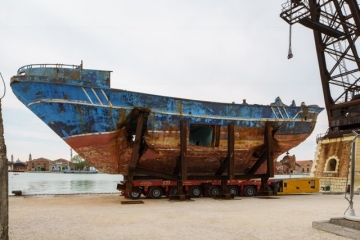Barca nostra - Our Boat
 Photo by Andrea Avezzù
Courtesy: La Biennale di Venezia
Photo by Andrea Avezzù
Courtesy: La Biennale di Venezia
On August 2, 2019, Bishop Paul Tighe visited the wreck of the ship that sank in the Mediterranean on April 18, 2015, which has been placed in the setting of the Venice Biennale Arte. He brought, in the name of the Holy Father, a word of appreciation for the initiative and a prayerful remembrance for the victims.
Barca Nostra - Our Boat
On April 18, 2015, one of the most tragic shipwrecks in the history of the Mediterranean took place between the Libyan coast and the Italian coast of Lampedusa. There were 28 survivors and between 700 and 1100 people lost their lives.
The boat, which became a tomb for people in search of hope, is now “our boat” because it is our humanity that has been wounded and sunk. This happens every time a hand stretched out in need is rejected, every time a drowning man, woman or child is left to die in the darkness of the water.
This boat has been recovered from the seabed: a whisper of humanity guided that gesture. Burying the dead has always been one of the great values of our culture because it expresses the compassion that makes us human. It really is “ours.” And today, it can become like a Trojan horse, taking away the hardness of our hearts and the cowardice of our fears. In this sense Barca Nostra - Our Boat is a work of memory that helps us to understand the world and our humanity. It is no longer a wreck. It is a manifesto. That is why it is being exhibited at the Biennale Arte. It is a work that, having become a symbol, now speaks to the humanity of all and surpasses real and symbolic boundaries.
“Adam, where are you?” asks God to a disoriented man who has lost his place in creation because he believes he can dominate everything. This boat now asks each one of us: “Adam, where are you?” Then God asks a second question: “Cain, where is your brother?” Are we no longer able to look after one another, have we lost the sense of fraternal responsibility? The globalization of indifference – Pope Francis recalls – makes us all like the “unnamed,” to use Manzoni’s imagery, i.e. people who should be responsible but have neither names nor faces.
Our boat is the wreck of an odyssey of rags, an Exodus without Moses. It contains stories, faces, people who are not heroes. Its journey has nothing exploratory, nothing exemplary. What is represented is the pain of being human, which does not end with the escape from war, but continues through the voyages and landings on the coasts of the West.
“The Raft of the Medusa” by Théodore Géricault comes to mind, depicting the shipwreck of the French frigate Méduse on July 2, 1816, off the coast of Mauritania. Barca Nostra acquires the value of a work of art because it shocks our usual understanding of the world and acts like a drug against the indifference of the heart.
It is only wood: there is no depiction of the drama or of its protagonists. The boat is a cross of today without its “poor Christ,” the empty cast of a tragedy not only asks to be admired and observed aesthetically, but, as in a Greek tragedy, exposes the visitor to the stormy demand for meaning. The dramatic beauty – and the Biennale Arte obliges us to accept the paradox of this “beauty” – of Barca Nostra unleashes an ethical tension that cannot fall into a vacuum if we wish to remain human.



